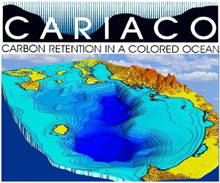Project: CARIACO Ocean Time-Series Program
Description
Since 1995, the CARIACO Ocean Time-Series (formerly known as the CArbon Retention In A Colored Ocean) Program has studied the relationship between surface primary production, physical forcing variables like the wind, and the settling flux of particulate carbon in the Cariaco Basin. This depression, located on the continental shelf of Venezuela (Map), shows marked seasonal and interannual variation in hydrographic properties and primary production (carbon fixation rates by photosynthesis of planktonic algae).
This peculiar basin is anoxic below ~250 m, due its restricted circulation and high primary production (Muller-Karger et al., 2001). CARIACO observations show annual primary production rates exceed 500 gC/m2y, of which over 15-20% can be accounted for by events lasting one month or less. Such events are observed in other locations where time series observations are collected, and suggest that prior estimates of regional production based on limited sampling may have been underestimated. The annual primary production rates in the Cariaco Basin are comparable to rates estimated using time series observations for Monterey Bay (460 gC/m2y; Chavez, 1996), and higher than previous rates estimated for Georges Bank, the New York Shelf, and the Oregon Shelf (380, 300, and 190 gC/m2y, respectively; Walsh, 1988).
The Cariaco Basin has long been the center of attention of scientists trying to explain paleoclimate. Due to its high rates of sedimentation (30 to >100 cm/ky; Peterson et al., 2000) and excellent preservation, the varved sediments of the Cariaco Basin offer the opportunity to study high resolution paleoclimate and better understand the role of the tropics in global climate change ( Black et al., 1999; Peterson et al., 2000; Haug et al., 2001; Black et al., 2004; Hughen et al., 2004 ).
Now, the CARIACO program provides a link between the sediment record and processes near the surface of the ocean. Sediment traps maintained by the CARIACO program show that over 5% of autochtonous material reaches 275 m depth, and that nearly 2% reaches 1,400 m. The significance of this flux is that it represents a sink for carbon and that it helps explain the record of ancient climate stored at the bottom of the Cariaco Basin.
Acknowledgements: This work was supported by the National Science Foundation (NSF), the National Aeronautics and Space Administration (NASA), and Venezuela's Fondo Nacional de Ciencia, Tecnología e Innovación (FONACIT). For more information please see this Acknowledgements link.

People
Lead Principal Investigator: Frank Muller-Karger
University of South Florida (USF)
Principal Investigator: Dr Robert C. Thunell
University of South Carolina
Co-Principal Investigator: Yrene Astor
Estacion de Investigaciones Marinas de Margarita (EDIMAR-FLASA)
Co-Principal Investigator: Dr Mary I. Scranton
Stony Brook University (SUNY Stony Brook)
Co-Principal Investigator: Gordon T. Taylor
Stony Brook University (SUNY Stony Brook)
Co-Principal Investigator: Dr Robert C. Thunell
University of South Carolina
Co-Principal Investigator: Ramon Varela
Estacion de Investigaciones Marinas de Margarita (EDIMAR-FLASA)
Contact: Laura Lorenzoni
University of South Florida (USF)
Contact: Dr Robert C. Thunell
University of South Carolina
Programs
Ocean Carbon and Biogeochemistry [OCB]
U.S. Joint Global Ocean Flux Study [U.S. JGOFS]
Ocean Time-series Sites [Ocean Time-series]
